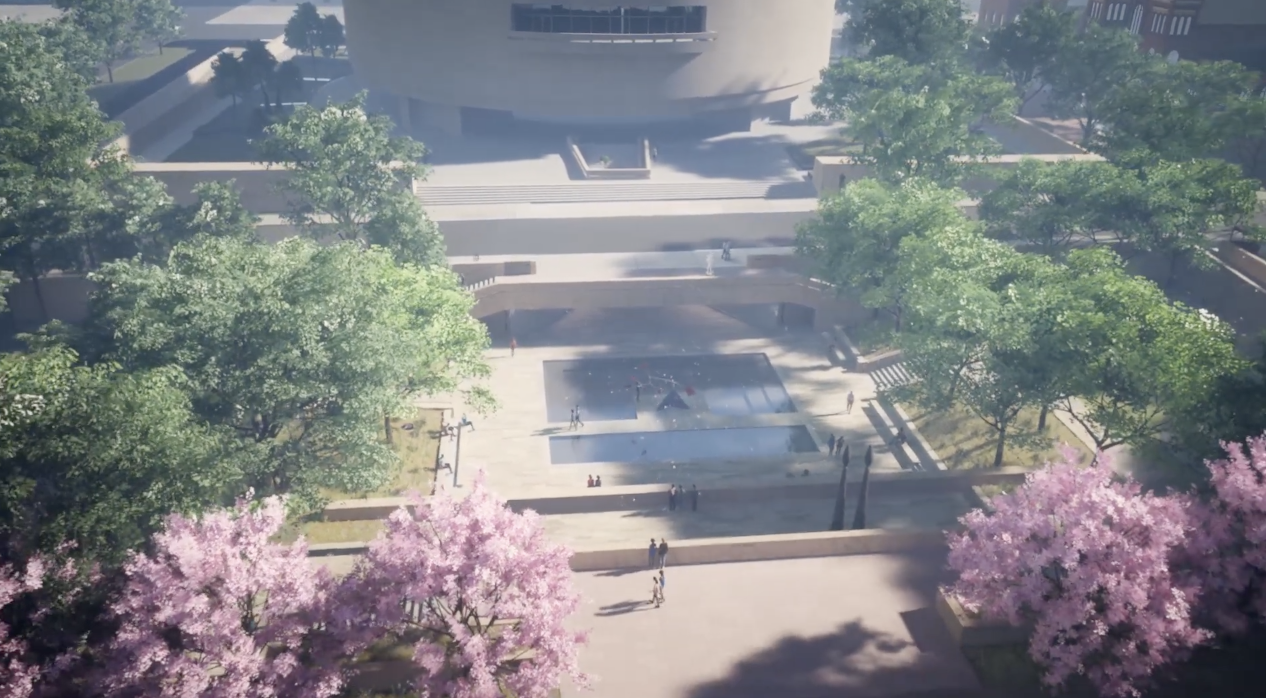(ATLANTA) — The drive down Huff Road in Atlanta, Georgia, takes visitors by mid-rise apartment complexes, industrial warehouses, and new-home construction, everyday scenes in this growing southern city. Few will be aware of the vibrant community that existed here decades before. Blandtown, an industrial Atlanta community once home to the first freed African Americans in the post-Civil War era, continues to lose its history to gentrification.
The community, located in the West Midtown area, was owned by Samuel Bland, a freed slave who purchased the land on Oct. 2, 1872 from its previous owners. The land was then passed down to his wife, Viney Bland, and partially willed to his son, Felix Bland, following Samuel Bland’s death in 1873. The first portion of the land was sold in 1892 as a part of a railroad stock purchase and the remainder sold by Felix Bland and his sister between 1916 to 1918 to the church. The community, named after Felix Bland, kept the family name—Blandtown.
Though the community saw progress during the early and mid-1900s, it slowly deteriorated with segregationist zoning schemes inflicted by the Atlanta City Council in the late 50s. As the 90s approached, the established African American families that once strolled the streets moved elsewhere – leaving behind the warehouses and a path for newcomers.
While many industrial companies are still in Blandtown, the vibe has shifted. Today, the town is known for its eateries, furniture stores, entertainment, and— soon—the latest stretch of Atlanta’s BeltLine.
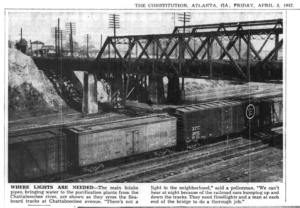
An article from the Atlanta Constitution showing the train line and freight as it appeared in Blandtown on Apr. 3, 1942. [Source: Gregor Turk’s website].
The question remains: Will the BeltLine expansion into Blandtown eradicate what is left of the town’s known history?
Rails to trails
What is now known as the BeltLine started in 1910 as a train line that numerous industrial companies used to transport parts and products within the Atlanta metropolitan area. Companies, like Ford Motor Company, used the 22-mile track to assist with the production of their goods.
Activity along the train line ceased in the 1960s until the Atlanta BeltLine Redevelopment plan was presented in November 2005. According to Beltline.org, the project was approved by the Fulton County Board of Commissioners, the Atlanta City Council, and the Atlanta Public School Board of Education in 2005 aiming for completion by 2030.
The city’s 2022 decision to expand the Northwest BeltLine trail through the community of Blandtown has come with mixed emotions from Atlanta residents who are aware of the town’s unique history.
“The area [Blandtown] is actually branding itself as an ‘entertainment’ district these days, and there’s also a strong cluster of furniture/interior design businesses,” explained Meaghan Mcsorley, a Ph.D. candidate in the School of City and Regional Planning at Georgia Tech who has studied the project. “It’s becoming more residential, but it’s almost exclusively high-end single-family homes and luxury condos/apartments. The history is mostly forgotten or unknown, as far as I can tell.”
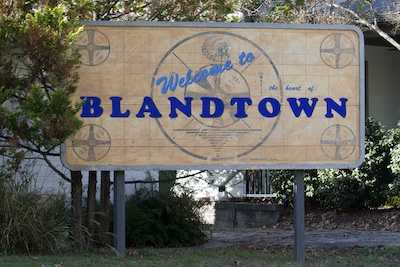
An image of the “Welcome to Blandtown” sign on English Street, at the front of Gregor Turk’s Art Exhibition of Blandtown’s historical memorabilia. [Captured by Valene Jones, Nov. 2022].
“It was very deliberate and it was timed with when this community was first moving in and how I found it was branded strictly as being West Midtown.” explained Gregor Turk as he explains the purpose of his creation of the “Welcome to Midtown” sign in an interview with Dr. Rhana Gittens, where they discuss Blandtown and her dissertation on “Displacing the ‘Black Mecca’: Romanticizing or Witnessing the African American Historical Trajectories in the Case of the Atlanta BeltLine.”
His efforts have taught new residents of Blandtown about the history of their community and enlightened visitors and tourists. Turk’s website shares newspaper articles about the community from 1897 to 2016, with one being a clipping from a 1922 real estate ad posted in the Atlanta Constitution newspaper titled, Colored Homes: Whitehall Loan & Realty Co.
“I hope that the Beltline will actually help make Blandtown’s history more visible,” said McScorley. “Having a few displays on this segment of the BeltLine would actually do a lot to make the history more widely known.”
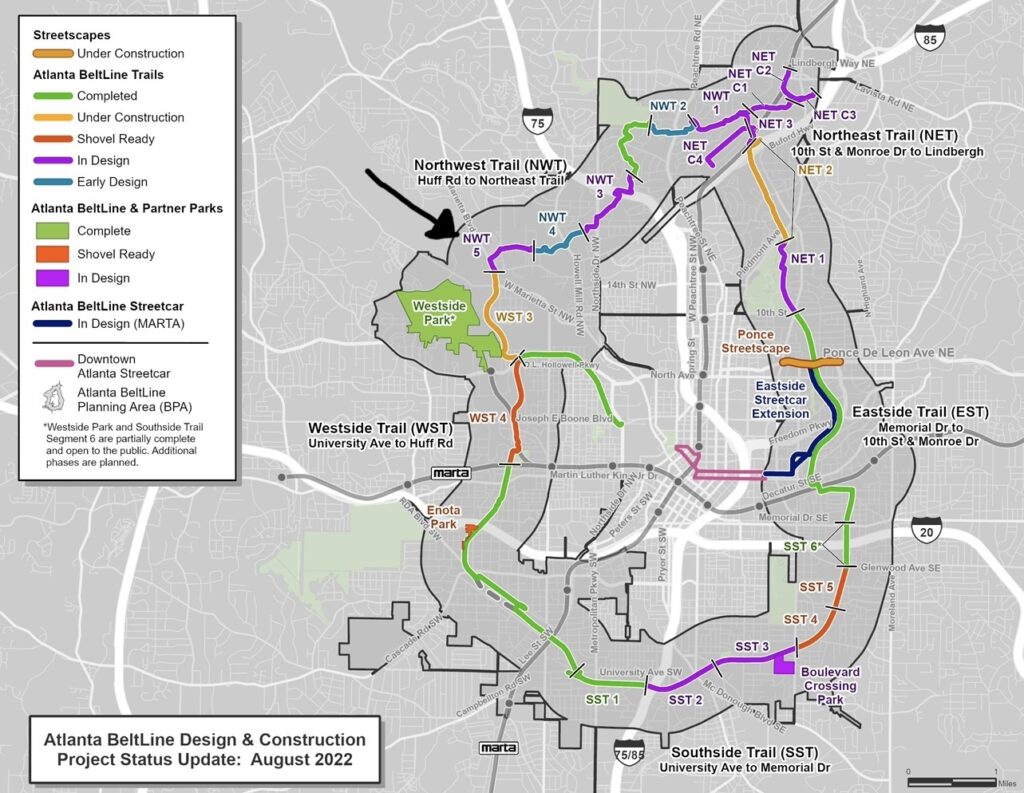
This map shows the entire outline of the BeltLine and the project’s current progress for each entry point. The Northwest Trail Segment Five, where Blandtown is located, is currently under design, [Credit: Atlanta BeltLine].
The Atlanta BeltLine has five main trails: the Northeast trail, located primarily in Buckhead; the Eastside trail, located in the Historic Forth Ward Park area; the Southside and Westside trails, primarily located in Downtown Atlanta; and the Northwest trail located in West Midtown encompassing Blandtown, Loring Heights, and Berkeley Park. The Northwest trail, where Blandtown is located, will run from Huff Road all the way to Marietta Boulevard. The estimated length of the future trail will be 2.8 miles.
“I like that the BeltLine is coming out this side [Blandtown],” explained Renee, a woman who used to work in Blandtown as she stood outside The Whelan, a new pub in the area. “They are fixing up the Westside and making it accessible to everybody.”
Blandtown still reflects its industrial past with many warehouses surrounding the area. But new construction of homes and apartments nearby are quickly changing the character of the area. Notable businesses, like Topgolf and Chattahoochee Food Works, can be found in Blandtown along with local mom-and-pops, like the Whelan and Northside Tavern, spread across the area.
“The BeltLine has gone through drastic development over the past few years, and I think it’s solidified its place as an Atlanta staple for positive community engagement,” explained Brandon Ogene, an Atlanta native living near the Eastside BeltLine trail. “With construction reaching its completion phase, it provides the opportunity for Atlanta locals and visitors to experience a newly refined aspect of the city we haven’t seen before.”
The BeltLine’s Eastside trail, one of the most popular entry points, has something for everyone—from shopping to exercising to socializing. The various shopping centers and housing units around the border of the trail, allow the BeltLine to generate income for the city, business owners, as well as prospective employees who are seeking employment at these locations.
The most popular attraction in the Eastside trail, Ponce City Market, was named after the 1800s Atlanta gathering location known as Ponce de Leon Springs (and named after Spanish explorer Juan Ponce de León) that existed on the land before the building of the market. At Ponce, the location’s history is remembered through their website, where a timeline of the land’s history is shared and explains how to the location has been transformed from Ponce de Leon Springs in the early 1900’s to a Sears in the 80’s, office spaces in the 90’s, and its current inhabitants now — the market. While the existence of entry points like the Eastside trail of the BeltLine, some Atlanta residents do not see the purpose of further expansion.
“I think the BeltLine does not need to be extended,” explained Atlanta-native Andrea Ellison. “They are just going to displace more people, most likely the non-gentrified parts, just to add to something that isn’t all that great in the first place.”
![An image of the old tracks that run across English Street in Blandtown. [Captured by Valene Jones, 2022].](https://theclick.news/wp-content/uploads/cache/2022/12/IMG_7893/3957975141.jpg)
Homes in this area have gone from being advertised for $4,250 in 1922 (equivalent to about $68,000 today) to $850,000 in 2022 . Seeing this, along with the population shift from predominantly African American to white attests to the effects of gentrification in Blandtown.
Minerva Homes, an Atlanta-based private-owned company, has begun construction in the Blandtown area of single-family and townhouse homes starting at $500,000 and going up to over $850,000 for 3-bedroom/4.5-bathroom models. While the land has been cleared and some homes are already built, others are still in production. The construction company is currently advertising the community’s construction through multiple banners around Blandtown sharing that the homes will be “directly across from the future BeltLine.”
However, with the Northwest trail still in the design and planning stage, many of the homes will already be built at the start time of the BeltLine’s physical construction. Despite this, it has not stopped early investors from purchasing homes within the Blandtown area—especially with the promise BeltLine access within walking distance of their homes.
Job opportunities and growth
According to the BeltLine Foundation, one of the main goals is to increase job opportunities and affordable housing for Atlanta residents. As stated on BeltLine.org, the main goal of the project is to make the Atlanta BeltLine the “global beacon for equitable, inclusive, and sustainable city life.”
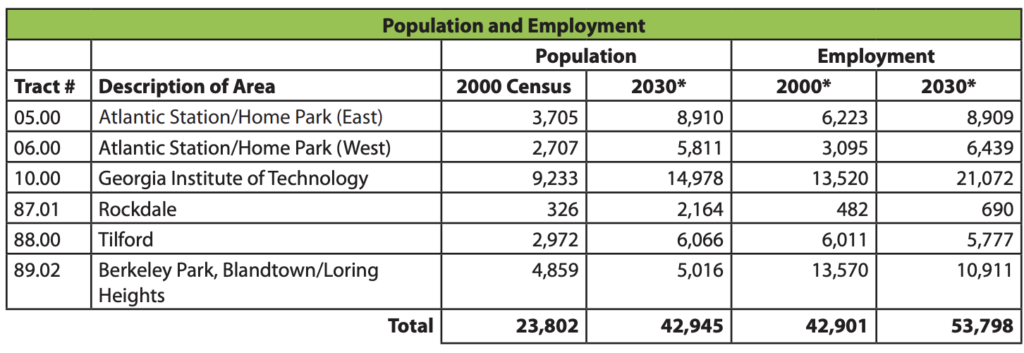
A chart from the 2011 BeltLine Inventory and Assessment Report, which shows a decrease in potential employment in the Blandtown area from 2000 to 2030. [Source: Beltline.org]
Since 2005, resident and member of the Blandtown Neighborhood Association during last year’s Atlanta BeltLine feasibility study stated that “There are not a lot of E/W routes through Blandtown, and the trail would create a more pedestrian-friendly environment. We spend a lot of time talking about improving sidewalks. Huff road isn’t great for pedestrians. Seems like a big miss to do something to save money that isn’t the best in the long term.”
What comes next?
What comes next for the community of Blandtown once the BeltLine once the Northwest trail is complete remains to be seen. With the town’s rich history unknown to many of the new residents and frequent visitors of Blandtown, the fear of total erasure as the Northwest BeltLine trail opens in the future is a plausible concern for the Atlanta-natives who are aware of the town’s original history.
“I hope that the BeltLine will actually help make the history [of Blandtown] more visible,” explained McSorley. “They [Atlanta BeltLine, Inc.] tends to support a lot of public art and public history, and having a few displays on this segment of the BeltLine would actually do a lot to make the history more widely known.”
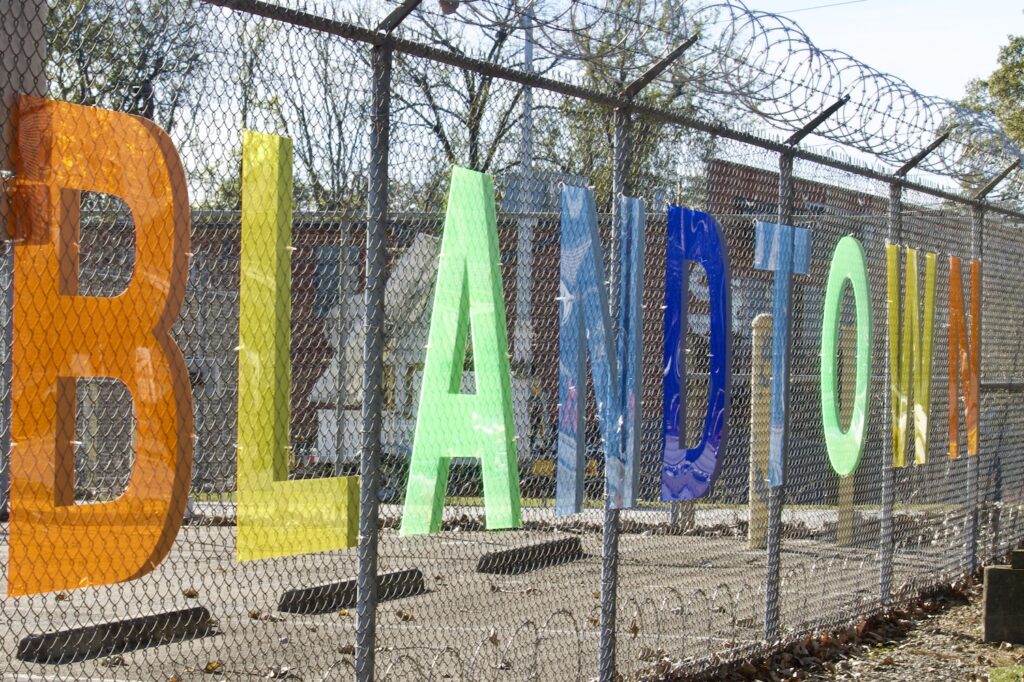
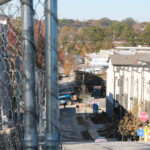

![An image of the new housing complex in Blandtown. [Captured by Valene Jones, 2022].](https://theclick.news/wp-content/uploads/cache/2022/12/IMG_7905/4144159446.jpg)
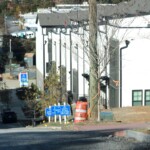
![An article from the Atlanta Constitution showing the train line and freight as it appeared in Blandtown on Apr. 3, 1942. [Source: Gregor Turk's website].](https://theclick.news/wp-content/uploads/cache/2022/12/Screen-Shot-2022-12-11-at-11_45_15-PM/1686090450.png)
